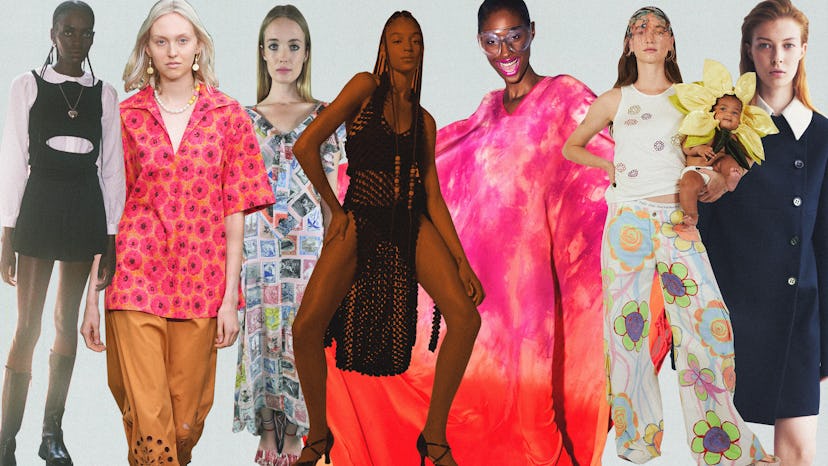New York Fashion Week Spring 2021 Recap: A Return to Fashion, For Now
A rundown of the highlights from New York Fashion Week: real-life shows at Jason Wu and Christian Siriano, understated genius at Sandy Liang and Khaite.

Well, that was quick.
If you blinked, you might have missed the past four days, which constituted New York Fashion Week for the spring 2021 season. What is usually a weeklong marathon of events, fashion shows at locations all over the five boroughs, after parties, and enough street style to clothe an entire country was pared down immensely this year. Brands that are usually headliners at fashion week chose to sit this one out. But a handful of them didn’t, choosing instead to get creative with the ways they showed their collections.
Jason Wu opened fashion week with an IRL runway show held atop Spring Studios, which still managed to attract a crush of photographers on the street.
The 36 attendees’ temperatures were taken, and they were seated six feet apart to see the collection, which took on the theme of escapism. Caftan-inspired dresses, mixed prints, loose silhouettes and Teva-esque sandals encapsulated the feeling of being vacation—something most people won’t be able to do for the foreseeable future. And Christian Siriano, one of the designers arguably most vocal and involved in creating PPE and masks during the height of the coronavirus pandemic in the city, chose to hold his show in the garden of his home in Connecticut.
Despite these two exceptions, the bulk of this year’s New York Fashion Week shows were held online, in the form of, as the CFDA put it, “digital activations.” Much like couture week, which took place remotely in July, most brands took the route of creating lookbooks and videos to display their wares. Unlike couture week, however, the spring/summer 2021 digital presentations weren’t over-the-top contests of who had the bigger, better, budget. (Which, if you think about it in the context of couture itself, kind of makes sense.) This time around, things were significantly scaled back, and a focus on the clothing came to the fore. Designers had time to mull over how they wanted to encapsulate this time with a collection, and in what ways they could express what was important to them through fashion.
Kate and Laura Mulleavy of Rodarte took their own house codes of romance and confection and applied them to a grounded, varied collection. Among oversize crewneck sweatshirts that read “J’aime Rodarte,” and silky pajama sets were drop-waist two-piece sets that called to mind the 1920s, and belted 1950s dresses. Some models wore ornate headpieces that framed their faces with clusters of flowers and bows. There was even a ruffled off-the-shoulder wedding dress, with beading throughout—plus, plenty of floral-printed frocks for flower girls to wear when it’s safe to congregate and celebrate holy matrimony again.
Anna Sui, Peter Do, Sandy Liang, and Khaite released standout look books—with some of our personal favorite fashions from this season, including a pouf-sleeved, polka-dot dress from Khaite, artfully photographed; leather boots at Peter Do; cutout tank tops and skirts at Sandy Liang, and Anna Sui’s trademark brand of whimsy.
Collina Strada and Chromat both released collections steeped in political messaging: Climate change for the former, and a focus on support for the trans, disabled, and LGBTQ communities for the latter. Collina Strada’s line was called “Change Is Cute,” and the teeny-tiny swimwear, cheerily printed slacks with matching masks, and asymmetrical jackets were modeled by Hawa and West Dakota. All the clothing and accessories were made from deadstock materials, which were viewed via a video whose trippy backgrounds included multicolored cornfields and cliffs covered in graffiti. Chromat’s line was a collaboration with Reebok called Joy Run, released through a video made by the filmmaker Tourmaline.
Ulla Johnson staged a runway show at Roosevelt Island’s Four Freedoms Park, which the brand documented on video unveiled on its website. With the Manhattan skyline in the background, models paced a colorblocked runway while the Staten Island singer-songwriter Shamiqua strummed a guitar in front of a microphone. It was one of the presentations that felt the most like being at a real fashion show, albeit with sharper video editing and tight production quality.
Tom Ford’s “show” for spring 2021 was largely regarded as the grand finale of New York Fashion Week—after all, he was the biggest name on the lineup. It couldn’t have been more different than his last show—a celebrity bonanza in Los Angeles attended by Jennifer Lopez, Tracee Ellis Ross, Lil Nas X, Miley Cyrus, Kylie Jenner, and Hunter Schafer. Like Wu, Ford’s collection, presented via look book, was inspired by the idea of an “escape”; it was an ode to travel, with a focus on animal and tropical floral prints. (The designer also brought back fishnets for this collection, which he famously sprinkled throughout his runways during his time at Yves Saint Laurent in the early Aughts.) Comfortable clothing, a necessity for nearly all designers to include in their lines this season, came in the form of boxing shorts with an elastic band that read, “Tom Ford.”
Alas, a look book does not a finale make. The real finale of NYFW was Siriano’s garden runway show: Billy Porter sat in the socially distanced grass, doing interviews; Coco Rocha closed the show by walking off the runway area and plunging into Siriano’s pool. Guests couldn’t hug to greet one another, but it certainly felt good to be among people again, looking at real, live fashion.